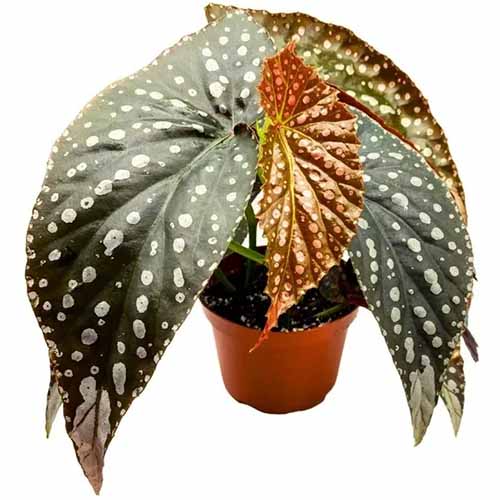
[ad_1]
Begonia coccinea, B. corallina, B. dietrichiana, and hybrids
I’m proud to say I used to be not the primary in my household to develop and look after an angel-wing begonia houseplant.
That honor goes to my daughter Frances, whose aunt Kathy gave her a five-gallon pot with a big, wholesome specimen for her eleventh birthday.
She stored it as a houseplant in her sunny bed room all through center faculty, dragging it open air for the summer season, fastidiously watering it, and deadheading the coral pink flowers.
I by no means needed to remind her to look after her angel-wing begonia. She took it on herself to study in regards to the plant and adopted ideas from aunt Kathy all through the three-foot-tall plant’s tenure at our madcap dwelling with the resident blended household of 5.
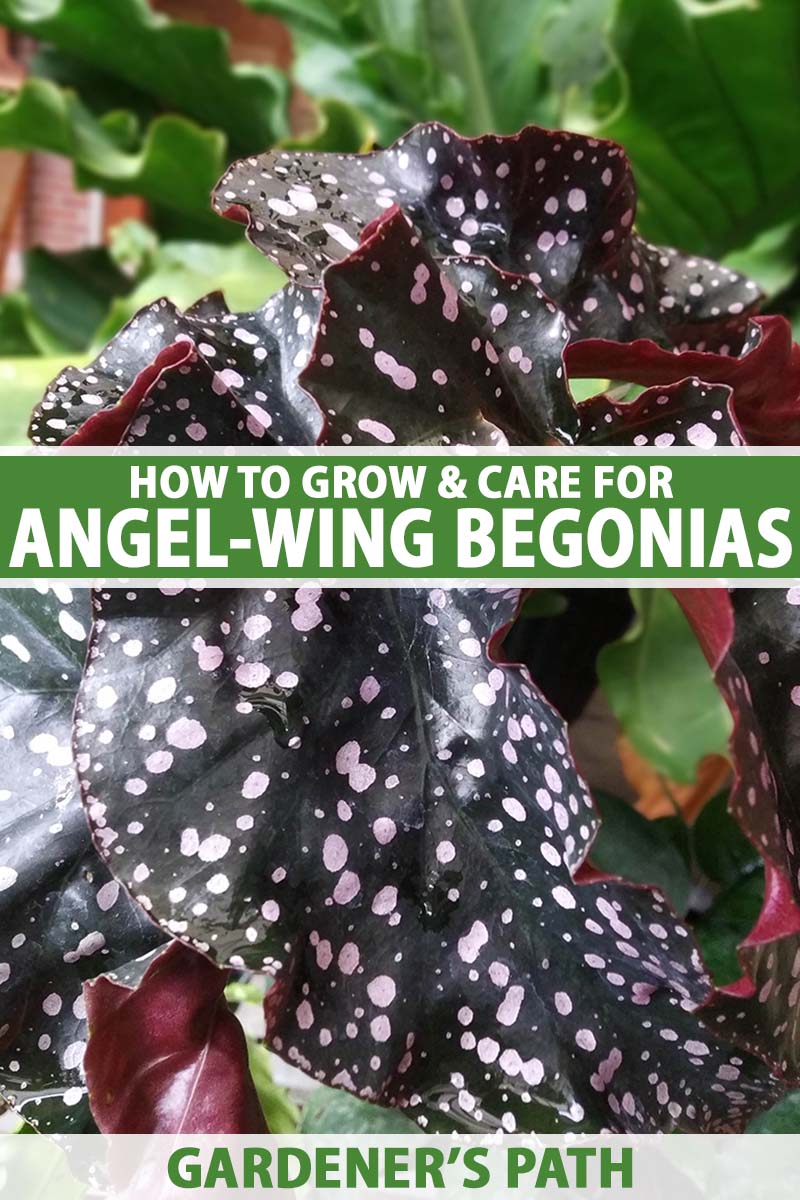

We hyperlink to distributors that can assist you discover related merchandise. In the event you purchase from one in every of our hyperlinks, we could earn a fee.
That plant lived and bloomed for not less than six years, an awesome run for a cane-like selection. I solely remorse that we didn’t notice how straightforward it could be to take cuttings and root the stems, or I think about we’d nonetheless have an offspring of that very same begonia at Newton Avenue all these years later.
I circled again to angel-wing begonias a few years in the past when looking for acquainted comforts throughout lockdown. I bought them from the identical South Knoxville greenhouse Fran’s plant got here from.
Hers, mine, and the various different forms of angel-wing begonia are outright beauties, particularly once you take note of their rising necessities. Chances are you’ll want to domesticate them indoors or open air or mix the 2 approaches.
The frequent title “angel-wing begonia” is used pretty loosely, making a little bit of a grey space on precisely which vegetation fall into the class.
I’ll clarify extra in regards to the classification, together with the situations once you wish to differentiate amongst varieties and when it’s cool to not trouble with distinctions.
I’ll additionally share a bunch of tips about rising and caring for these heavenly begonias.
Right here’s what you possibly can count on:
What Are Angel-Wing Begonias?
Angel-wing is the frequent title for just a few completely different begonias.
Botanical species normally accepted as being within the “angel-wing” class embody B. coccinea, B. corallina, and B. dietrichiana.
Widespread traits embody sturdy, upright stems with nodes that make them look a bit like slender bamboo, asymmetrical, wing-shaped leaves, and clusters of pink, white, or pink flowers borne on the canes.


The completely different species develop to between one and 6 toes tall, although they normally high out at about two to a few toes.
Most varieties have mild dots or streaks atop their leaves, typically with pink undersides.
The species B. dietrichiana is called the “heirloom” angel-wing begonia, and it has clean inexperienced leaves with out markings.
Some people consult with all cane-like begonias as angel-wings, however cane varieties typically have rounded, elongated, or star-shaped leaves.


You may additionally hear the favored polka dot plant, B. maculata, referred to as “angel-wing,” and it principally suits with this classification.
Polka dot vegetation develop thicker canes and waxier leaves than most cane begonias, although, and have bigger polka dots than the opposite species on this grouping.
They don’t flower as persistently because the others, both. They normally bloom solely in spring or summer season, if then – versus all year long. And their blooms are white and tiny, not pink or pink.
Simply bear in mind that whereas polka dot vegetation and different angel-wing begonias each want well-draining soil and rare, deep watering, B. maculata vegetation are pickier about mild and humidity.
As an alternative of medium mild, they’ll want vibrant, oblique mild.
Dragon wing begonias (B. x hybrida) are additionally generally referred to as angel-wings. These vegetation are a hybrid of B. coccinea and B. semperens, the everblooming wax begonia.
Dragon wings are extra compact than different cane-like varieties, with smaller leaves.
I’m not going to speak in regards to the dragon wings on this information since they’re normally thought-about a separate selection by growers and breeders alike. And as comparatively current hybrids, their rising wants are a bit completely different.
All of the varieties we’ll talk about on this information have fibrous roots and are straightforward to begin from cuttings.
You possibly can develop these evergreen vegetation open air as perennials solely in USDA Hardiness Zones 10 to 11, however they make lovely houseplants that bloom year-round with correct care.
You may also get pleasure from them as backyard or hanging basket annuals in cooler rising zones after which toss them within the fall. To me it looks as if a waste to trash them on the season’s finish.
As I discussed earlier, there are occasions when it’s vital to distinguish between a cane-like angel-wing begonia and different species that look form of related.
Hardy begonias, B. grandis, are one instance. They’ve rounded, paisley-shaped leaves that appear like wings if you happen to strive exhausting to persuade your self, and so they produce flowers much like many angel-wing varieties.
The explanation you don’t wish to by chance find yourself with a hardy kind once you’re looking for a cane kind is that hardy varieties aren’t evergreens, so that they lose their leaves when the climate will get chilly.
Subsequent are the foliage-first rex begonias, B. x rex cultorum. A lot of these patterned cultivars have wing shaped-leaves.
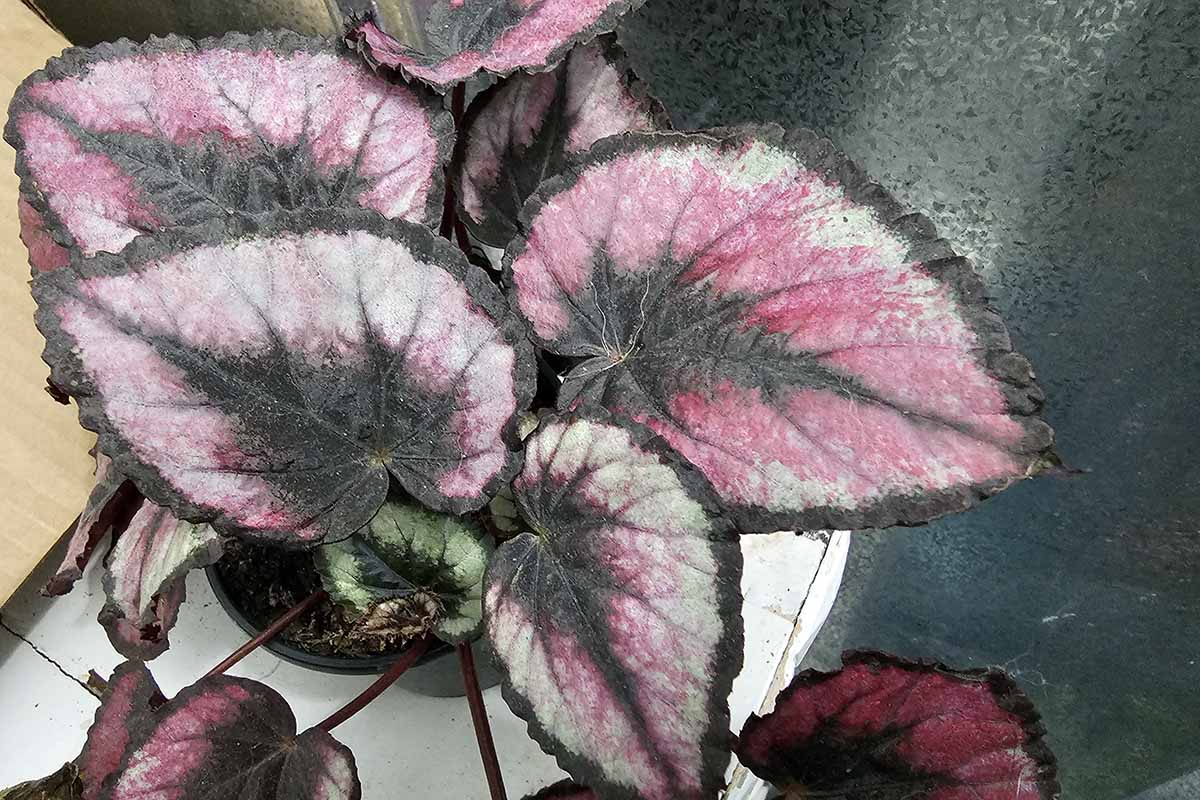

I included a photograph of one in every of my “painted leaf” rex begonias above to indicate you ways straightforward it could be to suppose they had been angel-wings.
However the rex varieties are a bit fussier than the cane varieties, particularly once you attempt to develop them open air, and the rising necessities differ considerably.
Most B. x rex cultorum cultivars sprout leaves from rhizomes, for instance, so that they should be positioned with the rhizome half buried within the soil, not planted with the crown on the soil floor like cane varieties.
The dearth of canes makes colourful rex begonias tougher to propagate, too, so that they’re not as straightforward to share as the everyday B. corallina or B. coccinea, both.
You’ll discover lots to suggest rex begonia cultivation in our information.
Forward of the rising info, let’s take a minute to study in regards to the background of the sleek, cheerful angel-wing begonia.
Cultivation and Historical past
Angel-wing begonias are a part of the cane-like grouping decided by the American Begonia Society. Many of the cane-like species are native to elements of Brazil.
They’re all categorised throughout the Begonia genus Franciscan monk and botanist Charles Plumier first described greater than 4 centuries in the past, in 1700.
Europeans fell in love with a majority of these vegetation shortly, and recognized 200 species between 1700 and 1850, and begonias have been standard with flower and indoor gardeners to a point ever since.
Many begonias, together with the cane varieties, are simply hybridized, and even beginner breeders have efficiently launched new begonia cultivars.
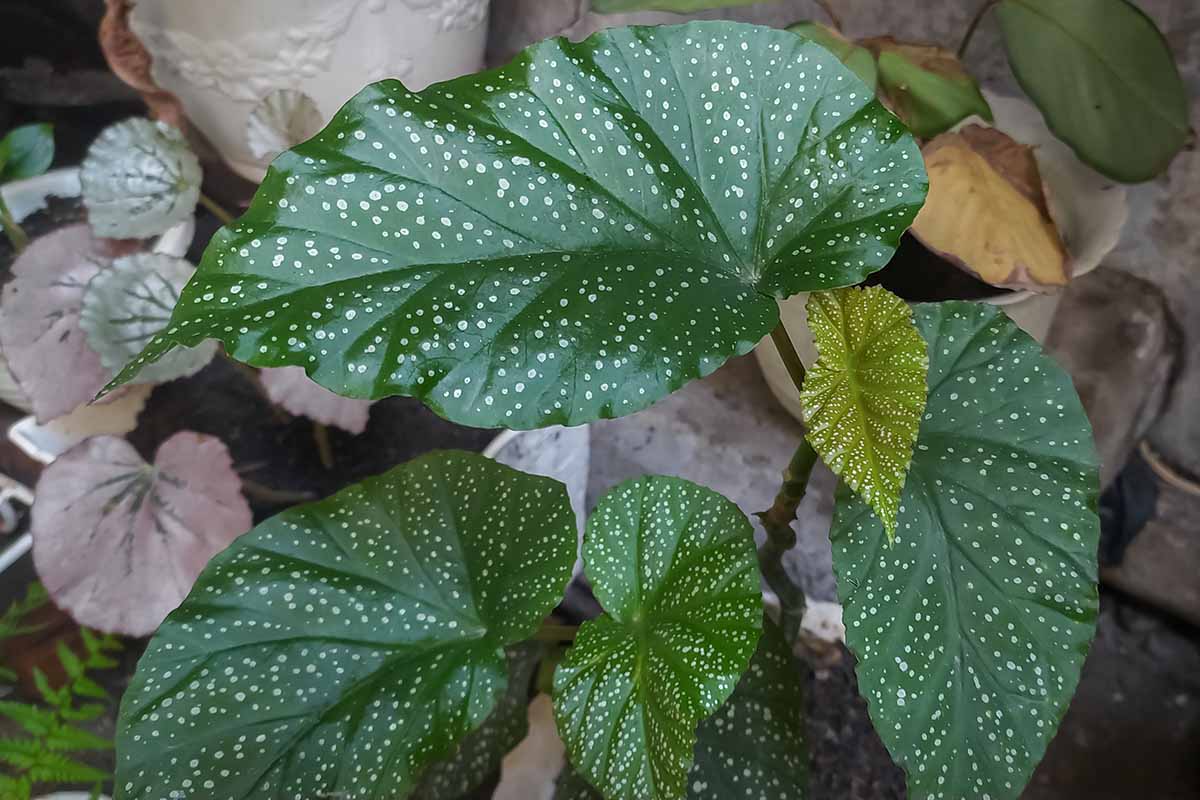

One of many earliest recognizable cultivars was launched by a Swiss nurseryman in 1892 and is called B. corallina ‘De Lucerne’ or B. ‘Lucerne.’
It has olive leaves with silver flecks and is a guardian plant for lots of the varieties standard right this moment.
‘Lucerne’ vegetation are fairly exhausting to search out at peculiar nurseries within the US however nonetheless have their devotees.
In response to the American Begonia Society, as extra begonias with wing-shaped leaves got here on the scene, they too picked up the title angel-wing, even when they had been shrubby or trailing, not cane varieties.
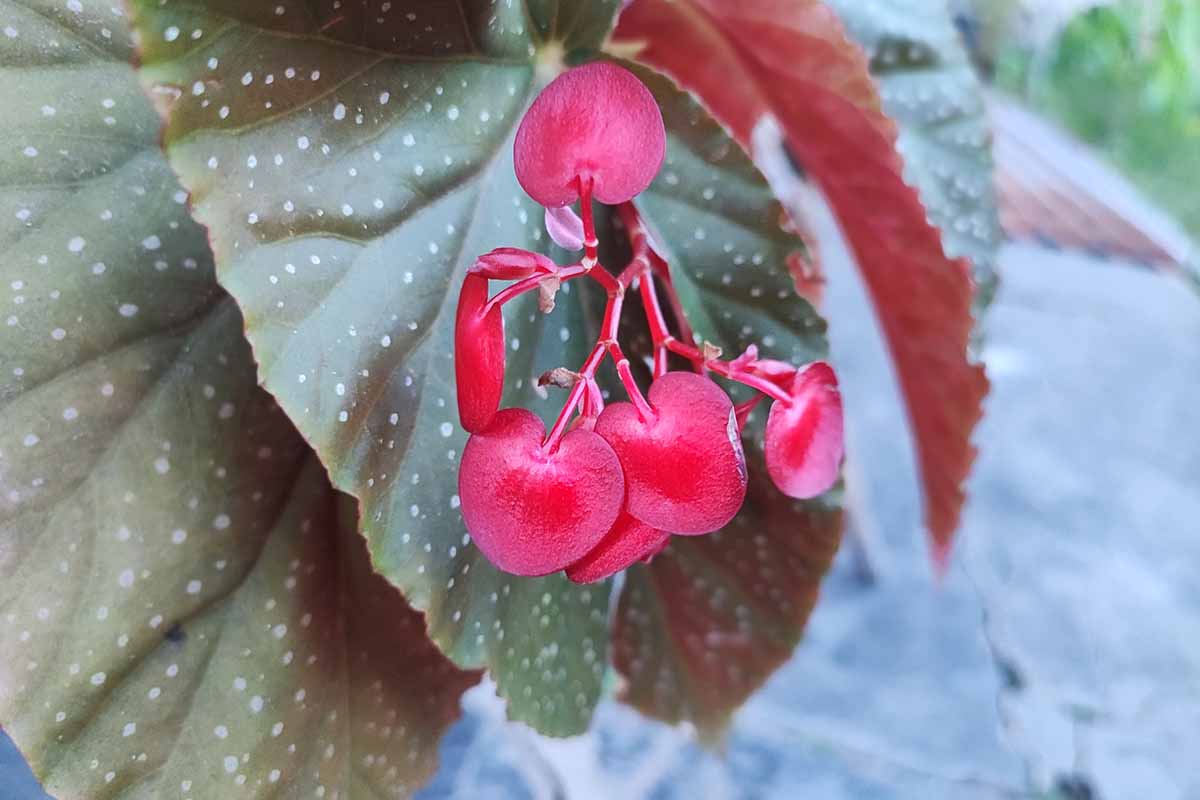

Because the years glided by and the title began getting used indiscriminately, many hybridizers and residential growers stopped utilizing it altogether.
One other subgroup of cane varieties, the Superbas, has many members categorised as angel-wings.
A house hybridizer, Eva Kenworthy Grey, pioneered the Superbas. She started crossing fibrous begonia varieties within the Twenties in California.
In 1926, she crossed a Brazilian selection, B. aconitifolia, with a B. coccinea ‘Lucerne’ from a non-public assortment.
The cross resulted in a cane-like selection that includes deep toothed margins and delicate silver markings on massive, asymmetrical leaves. The begonia world took observe, and different Superba hybrids adopted.
They included a cross of ‘Lenore Olivier’ and ‘Kentwood,’ from Grey’s fellow Californian, Irene Nuss.
The ensuing cultivar, named ‘Irene Nuss’ has massive, deeply frilled bronzed leaves, upright canes, and quite a few clusters of outsized pink flowers.
‘Irene Nuss’ received a Royal Horticultural Society’s Award of Backyard Benefit in 1971 and it has remained standard amongst Superba followers ever since.
Now that you simply’ve seen among the prospects, let’s speak about how you can propagate these vegetation.
Angel-Wing Begonia Propagation
One of many nice joys of proudly owning an angel-wing begonia is having the ability to root cuttings from it virtually at will.
With the convenience of that strategy, it’s unappealing to attempt to develop these varieties from seed until yow will discover pelleted seeds from a good supplier or plant breeder.
Hybrids produce seeds that received’t develop true to the guardian plant, and so they could also be sterile.
Species vegetation could produce seeds, however they’re fairly tiny and tough to work with indoors – you’d want a magnifying glass and not less than two folks to strive.
It’s not possible to immediately sow them within the backyard, both – they merely disappear.
With that mentioned, if you happen to luck out on pelleted seeds, sow them indoors eight to 10 weeks forward of your common final frost date in Zones with chilly winters.
You’ll find step-by-step directions for beginning seeds indoors in our information, however take into consideration begonia seeds want mild to germinate.
You may also plant pelleted seeds open air in Zones 10 to 11.
As for taking cuttings, that is a straightforward propagation methodology as they take just some weeks to root.
You possibly can propagate cane cuttings at any time of yr.


Be certain the guardian plant is wholesome and enormous sufficient to lose just a few stems and nonetheless have not less than two-thirds of its foliage remaining, to permit for photosynthesis.
I wish to root a few canes concurrently to extend the percentages that not less than one will succeed, and to have some to share.
Ordinarily I’ll root every stem in its personal pot or glass of water so the roots don’t get entangled, however you possibly can propagate a number of collectively after which transplant them en masse to develop collectively if you happen to want.
Select wholesome stems which have not less than two nodes. Lower a phase about 4 inches lengthy utilizing sterile scissors or a paring knife.
Pinch off all however the high two units of leaves.
At this level, you could wish to dip the underside of the clipped stem in rooting hormone to hasten root improvement. This step isn’t crucial, although it’s going to enhance your possibilities of success.
Subsequent, stick the underside of the stem right into a cell, tray, or shallow pot of pre-moistened, well-drained potting combine.
Set the container in a protected spot that receives six hours or extra of vibrant, oblique mild with out direct solar.
Preserve the soil moist with a sprig bottle of tepid water, being cautious to not get the soil too soggy.
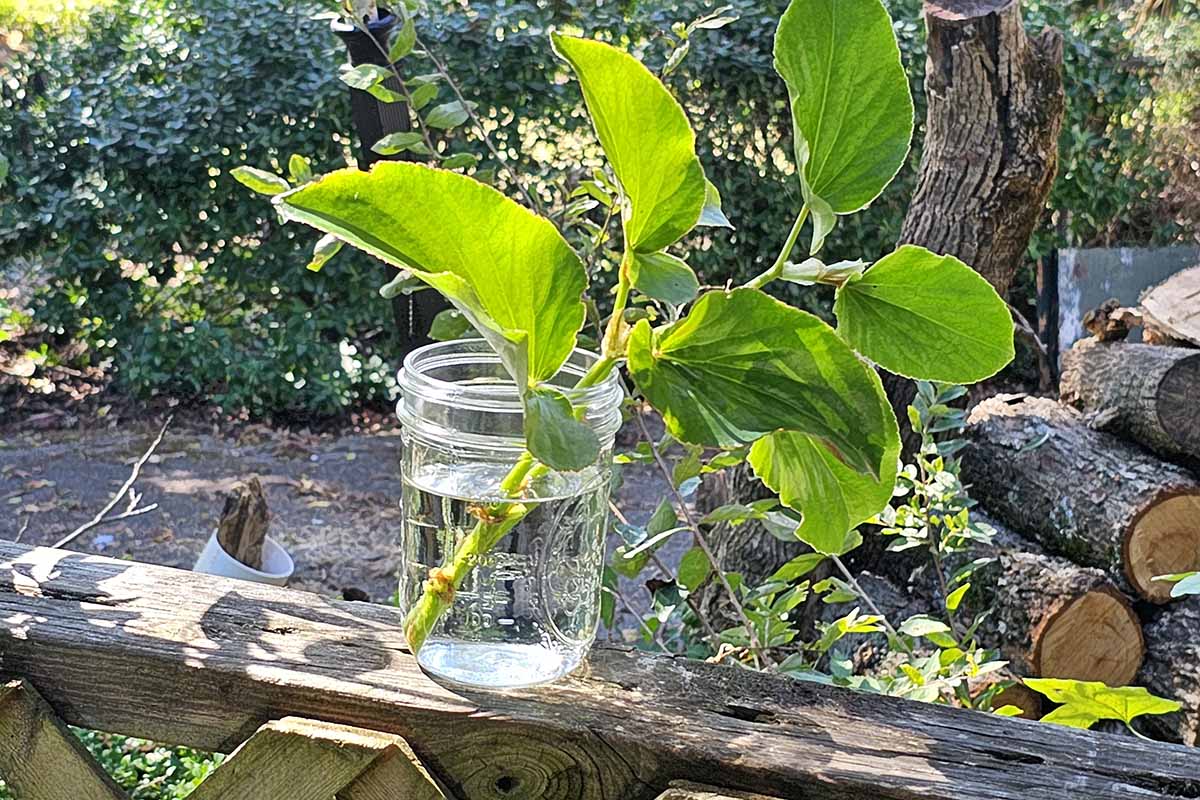

You may also root cuttings in a small glass of water. Ensure that the nodes are under the water line, whereas the leaves keep above it.
Each couple of days, change out the water to stop rotting.
When the roots are an inch lengthy, you possibly can plant the begins in containers or immediately right into a raised mattress or backyard after hardening off the seedlings.
Instructions for transplanting are coming proper up.
Transplanting
Even the healthiest begins want a little bit of TLC at transplant time. Listed below are the fundamentals:
Outside
In the event you dwell in Zones 10 to 11 or want to develop angel-wings as annual bedding vegetation in Zones 3 to 9, you possibly can transplant store-bought begins or rooted canes immediately right into a backyard or raised mattress in spring.
First, it’s advisable to take a look at the soil and amend it as obligatory. These vegetation like a pH of 5.5 to six.5.
Including loads of natural matter will enhance drainage, and spacing the vegetation about 30 inches aside will enable room for air to flow into.
Use a trowel or spade to dig a gap as deep as the present container, and some inches wider.
Ease every transplant out of its cell or container and set it within the gap so the underside of the cane is even with the soil floor.
Backfill with well-draining soil.
Water the transplants completely, ensuring the soil drains properly. Then be additional attentive to protecting the soil persistently moist for the following 4 to 6 weeks, till the vegetation are well-established and may tolerate the occasional dry spell.
Indoors
For my cash, containers are the best way to go if you happen to dwell in a cooler local weather.
I motive that you simply’ll must overwinter the vegetation indoors, so that they’ll want pots and contemporary potting combine in late summer season regardless.
It’s easier simply to develop them in containers full-time if you happen to dwell the place winters are chilly and keep away from the stress concerned in uprooting bedding vegetation and getting them acclimated to residing in a pot.
Select a pot with drainage holes that’s light-weight for straightforward toting. In the event you’re repurposing a container, make sure you wash it first and at all times use contemporary potting combine.
It’s ever really easy to switch water molds and fungi once you use previous soil for a brand new plant, particularly if the previous occupant of that pot succumbed to a illness.
The planter ought to be two or three inches wider than the beginning or the grower’s pot you’ve bought.
Fill it with a humus-rich potting combine that’s well-draining and formulated for decorative indoor vegetation.
Depart not less than an inch between the highest of the potting combine and the rim of the planter so the contents received’t spill out once you water.
Discover extra tips about selecting containers in our information.
Take away every begin from its present pot, tray, or cell by turning the container on its facet, then easing the plant out along with your fingers, holding the bottom of the stem and tugging gently.
In the event you rooted a slicing in water, pull the beginning up by its stem base, not the leaves.
Create a gap that’s the identical depth because the fibrous roots and two inches wider in diameter than the foliage.
Heart the beginning within the gap, backfill with extra of the rising medium, and water completely.
From there, get able to get pleasure from an indoor flowering plant that’s fast-growing and straightforward to look after.
Tips on how to Develop Angel-Wing Begonias
Angel-wing begonias will reward the trouble if you happen to take the time to supply their optimum rising circumstances. Listed below are the fundamental issues:
Location
Outside, any such begonia wants well-draining, nutrient wealthy soil and an element shade publicity.
It will possibly even develop and flower in full shade, however it’s going to have fewer blooms and sometimes received’t be as full or tall as those planted the place they obtain morning solar and afternoon shade.
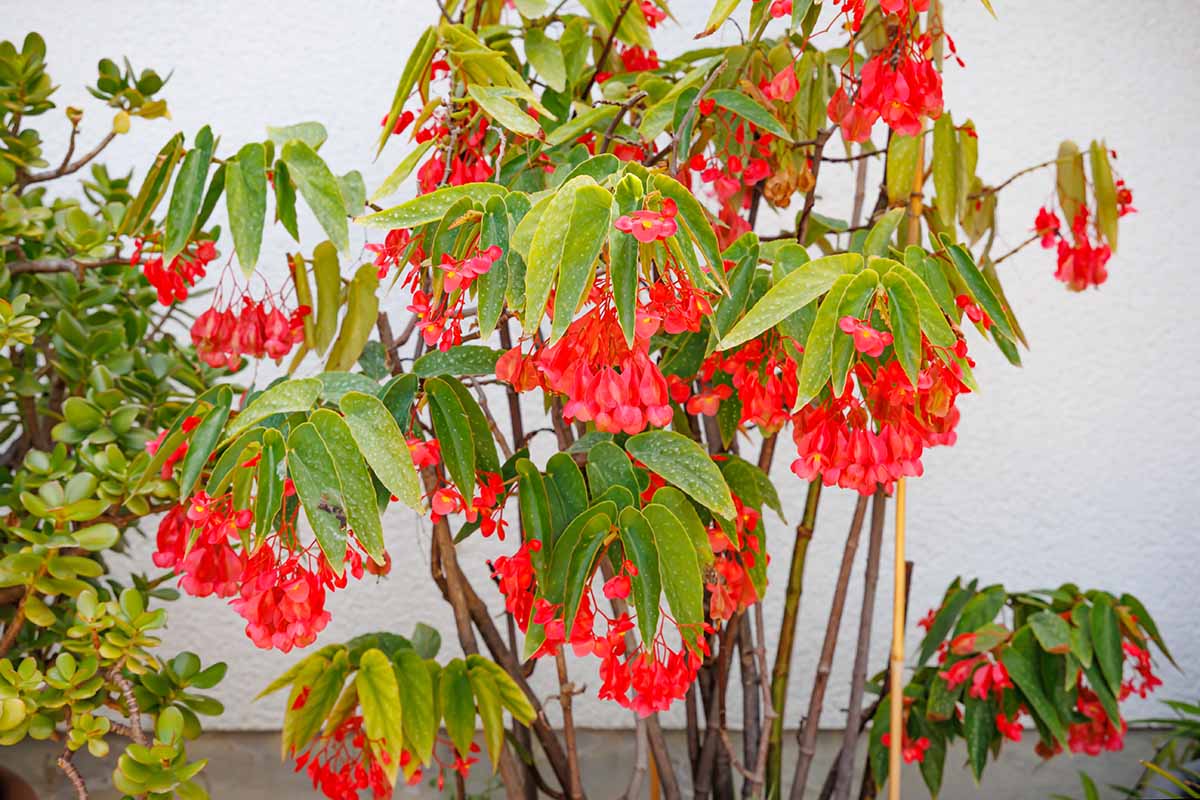

In the event you dwell in Zones 10 to 11, you possibly can plant them within the floor. Bear in mind the canes can develop a number of toes tall, so keep away from areas susceptible to excessive winds that might knock them over.
In Zones 9 or decrease, they will’t develop open air full-time and can want an acceptable indoor location for not less than a part of the yr.
When contemplating the place to put them, bear in mind all begonias comprise insoluble calcium oxalates that may trigger reactions together with vomiting or salivation when a cat or canine ingests a chunk.
Preserve the vegetation on a excessive shelf, or some other place out of attain of inquisitive or foolhardy pets.
I like the highest of my fridge as an choice, because the kitchen presents ample humidity and the equipment sits in entrance of a sliding glass door that receives morning mild.
Oh, and, even the extra-inquisitive cat received’t climb up there.
Name your veterinarian in case your pet samples any a part of the plant. The poisonous response is much less of a problem for human children since biting right into a leaf creates an odd style and ugly sensation instantly.
Gentle
Whether or not you’re planning to develop angel-wing begonias indoors all yr or merely transfer them inside when it’s chilly out, plan to supply a spot with vibrant to medium-bright mild with out exposing the leaves to direct daylight.
It might sound odd that these vegetation can develop in substantial shade open air however want plentiful oblique mild indoors, however that’s the best way it’s.
In the event you don’t have an area not less than a few toes from a sunny window obtainable, strive utilizing develop lights to supply the required illumination.
Temperature
Not too scorching, not too chilly… the just-right temperature is 70 to 75°F by day and round 60°F at night time.
Temperatures between 50 to 60°F could gradual development and blooming, and people over 85°F can stress the plant and trigger it to lose leaves or cease flowering.
In fact, it’s robust to regulate Mom Nature open air, however you should use a shade fabric if the warmth index is hovering or transfer container vegetation inside for just a few days.
Inside it’s solely doable to develop angel-wing begonias in a spot away from drafts and the place temperatures don’t fluctuate by quite a lot of levels in the course of the day or in a single day.
Water
As soon as vegetation are established and have acclimated to their rising setting, you’ll must water them completely, however solely when the soil dries out.
These aren’t the kind of vegetation that reply properly to dribs and drabs of water as you go by, so restrain your self if you happen to’ve been identified to overwater houseplants up to now.
As an alternative of setting a schedule, water when the highest inch or two of the soil is dry. You possibly can decide the moisture stage with a moisture meter or by jabbing your pinkie into the sting of the potting combine.
In winter, they normally want much less frequent watering, however let the soil be your information.
All the time water the vegetation till you see water popping out of the underside drainage holes, utilizing room temperature or tepid water.
I want backside watering, which you’ll study extra about in our information.
In the event you don’t backside water, be sure to pour water on the soil floor, not excessive of the leaves.
Watering cans are cute, however once you enable water to drip onto the leaf surfaces, they will’t at all times dry readily, and it would encourage illnesses or stem rot.
Let the vegetation drain right into a saucer under for not less than quarter-hour after a watering session, after which discard the surplus. All begonias detest moist toes.
Humidity
Begonias thrive in a humidity stage of not less than 40 % and as a lot as 60 %, however could do okay with barely much less or barely extra.
A superb rule of thumb: keep watch over the foliage. If the leaves begin to flip brown on the ideas the vegetation seemingly want a humidity enhance.
Often, a pebble tray with water beneath the underside of the pot will work, although if the air is especially dry in your house, you could wish to put money into a humidifier.
Fertilizer
Angel-wing begonias profit from common fertilizing when they’re actively rising.
About as soon as a month in the course of the spring and summer season, apply a liquid 20-20-20 (NPK) fertilizer diluted to half the power really useful by the producer.
Maintain off throughout fall and winter, and resume once more as soon as the vegetation enter prime rising season within the spring.
For extra ideas and methods on rising begonias as houseplants, see our information.
Rising Suggestions
- Develop partly shade open air and vibrant to average oblique mild inside.
- Water completely when the highest inch or two of soil is dry.
- From spring to early fall, fertilize as soon as a month with a liquid 20-20-20 fertilizer diluted to half the really useful power.
- Indoors, keep daytime temperatures of 70 to 75°F and 60°F at night time.
Pruning and Upkeep
Cane begonia varieties can dwell as much as six years earlier than changing into weak and spindly and prepared for the compost.
You possibly can promote their well being and sweetness over the lengthy haul with just a few upkeep chores.
First, persistently deadhead the spent blooms, particularly on vegetation grown indoors. Take away any lifeless leaves or stems that fall on the soil, too, to stop fungal illnesses.


Second, fastidiously time once you transfer indoor/outside vegetation to a brand new locale.
Set textual content reminders, or use a gardening journal, and watch the climate forecast. These beauties will repay the vigilance!
These ornamentals should come inside forward of nighttime temperatures falling under 50°F and never exit once more till all menace of frost has handed and the climate is reliably 60°F or hotter.
Make the transfer step by step within the spring so your begonias can get used to the unfamiliar setting. Begin by inserting the vegetation open air for just a few hours on the primary day and an additional hour or two on the next three days.
In the event you transfer them open air immediately, they might turn out to be confused by the sunshine and temperature fluctuations and drop leaves, cease rising or blooming, and even die again.
As a part of your upkeep, it’s a good suggestion to prune gangly vegetation from time to time.
Beginning after they’re a few yr previous, trim again the highest six inches of the canes in early winter and once more in spring. You may also form the vegetation or restrict their top by trimming off the ends extra typically.
You’ll finally must re-pot them too, however don’t rush. They like to be a bit potbound and normally solely want a brand new dwelling as soon as each two or three years.
Transfer them to a container simply two inches wider than their earlier dwelling, and think about beginning just a few cuttings once you do.
Angel-Wing Begonia Cultivars to Choose
As a result of the “angel-wing” moniker is used considerably indiscriminately, you’ll want to protect towards native nursery choices which can be labeled as angel-wings however are rex or wax begonias, with very completely different rising wants.
I’ve seen distributors promoting coleus, anthurium, and peace lilies underneath the angel-wing label, too.
Specialty plant nurseries are normally one of the best supply of the rarest varieties, although you could come throughout them on-line. In both case, count on to pay a premium for essentially the most uncommon ones!
Begonia fan that I’m, you already know I’ll advise you to amass those you will get your palms on readily and broaden your assortment with any “dream” varieties in your checklist as you discover them.
To get you began, try these cultivars:
Concord’s Ghost Angel
This hybrid cultivar appears to be like very a lot alive, with elongated leaves in a sprightly inexperienced, draping from upright canes.
With correct mild and care, its clusters of white blooms might seem in any season.
The ghostly side comes from small donut-shaped blips of luminous white on the leaves, together with random silvery splotches.
Bred to be low-maintenance and resilient, this cane begonia just isn’t a bit scary to look after.
You’ll find Concord’s ‘Ghost Angel’ in a six-inch pot obtainable from Bubbleblooms through Amazon.
Concord’s Little Wing
It’s all in regards to the foliage on this offbeat cultivar that’s an unique Concord hybrid.
Its four-inch leaves are shorter than most related cane-like varieties and have intriguing indents on the margins.
The colours are eye-catching, from the pink flowers to the moss inexperienced leaves with luminous pink undersides.
Its mild grayish-pink freckles and splotches match the slim strip of coloration on the leaf margins.
Name it little, nevertheless it’s large on fashion.
Concord’s ‘Little Wing’ is out there in a six-inch container from BubbleBlooms through Amazon.
Concord’s Raven
This dramatic selection will carry you up on a raven’s wings.
The leaves begin out crinkled and auburn-hued, turning a darkish olive inexperienced at maturity.
The foliage sports activities aluminum flecks and spots, with silver ideas that might be equally at dwelling on a raven’s wing ideas.
Indoors, count on the plant to develop about two toes tall, with the asymmetrical leaves presenting a layered impact.
Concord’s ‘Raven’ is out there in a six-inch pot from Bubbleblooms through Walmart.
My Particular Angel
All cane begonias are particular in my e book, however this one is distinguished by its pretty angular “wings” with wavy margins and silvery spots.
‘My Particular Angel’ will develop not less than two and a half toes tall at maturity.
Consistent with the angel theme, its silver markings and pink blooms complement vegetation with pink blooms or foliage as a part of vacation decor.
‘My Particular Angel’ starter vegetation can be found as naked roots from SmartMe through Amazon.
Managing Pests and Illness
Most of these begonias are persistently wholesome and straightforward to have a tendency, however can nonetheless sometimes have points with pests and illness. Right here’s what to observe for:
Pests
Outside, if you happen to’re stricken by deer munching in your bushes and vegetation, you could wish to give angel-wing begonias a strive – if you happen to’re in an acceptable Zone.
The calcium oxalates they produce make the foliage style unhealthy, but when deer persist, they’ll normally go for smaller specimens they will simply uproot.
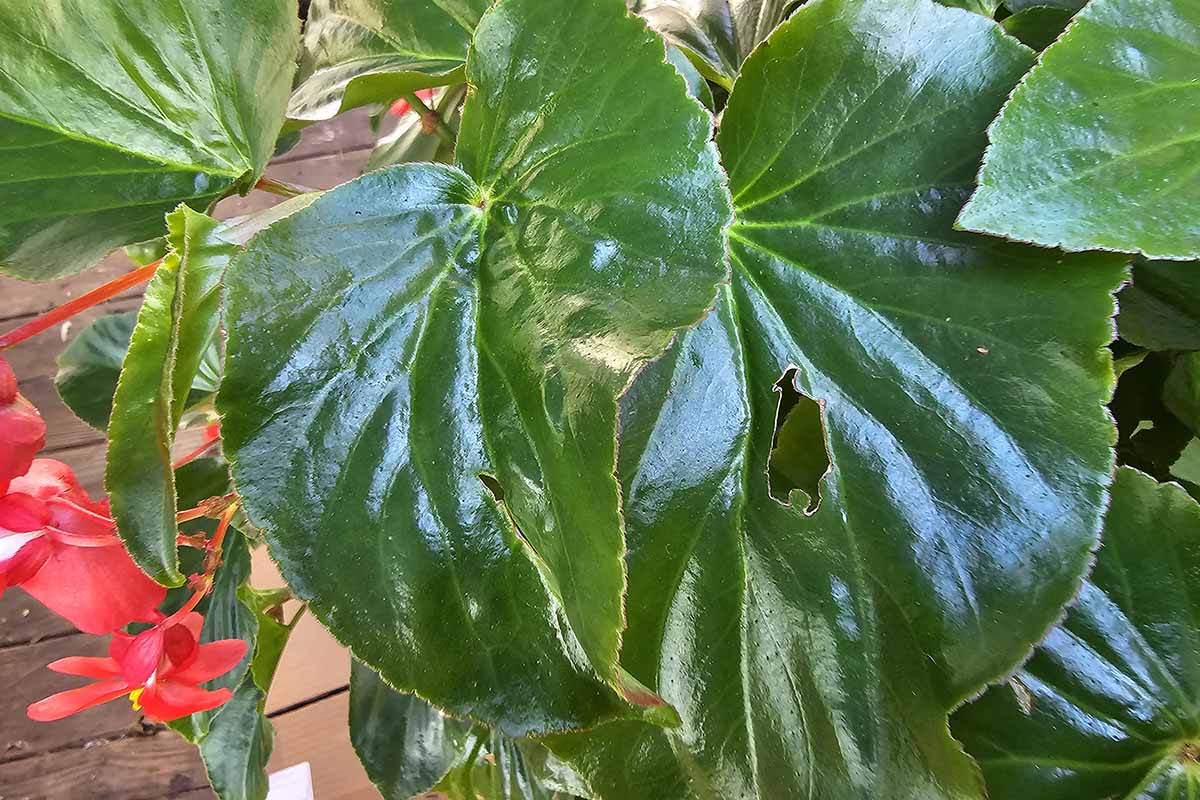

Rabbits, too, are identified to keep away from the sharp style of the leaves. However that declare principally applies to full-grown rabbits because the kids don’t have the expertise to note the discouraging style as shortly.
For them, you could place pots out of attain and use row covers to guard tiny, tender begins early within the spring.
As for insect pests, none of them are notably keen on angel-wing begonias, however they might infest outside vegetation or soar over to begonias from different contaminated home or bedding vegetation.
One of the best prevention is to test the leaves fastidiously for bugs, spider mites, and gastropods forward of transferring vegetation inside for the winter.
A blast of water from the hose is normally sufficient to ship these pests on their means. In the event that they hold reinfesting, you could want to show to an software of neem oil, which acts as a pure fungicide and pesticide.
A few of the most typical bugs and arachnids you may encounter embody spider mites, mealybugs, scale, and thrips. You’ll find info on detecting and combating every in our guides.
Personally, I’ve had a little bit of hassle with snails and slugs whereas my angel-wing begonias are having fun with the good open air in spring.
In the event you’ve seen jagged holes within the foliage, these gastropods may very well be the wrongdoer.
Be taught to identify snail and slug harm and handle it utilizing ideas from our information.
Illness
You possibly can keep away from most illnesses that afflict angel-wing begonias by giving them ample house for air circulation, rising them in well-draining soil or potting combine, and by no means overwatering.
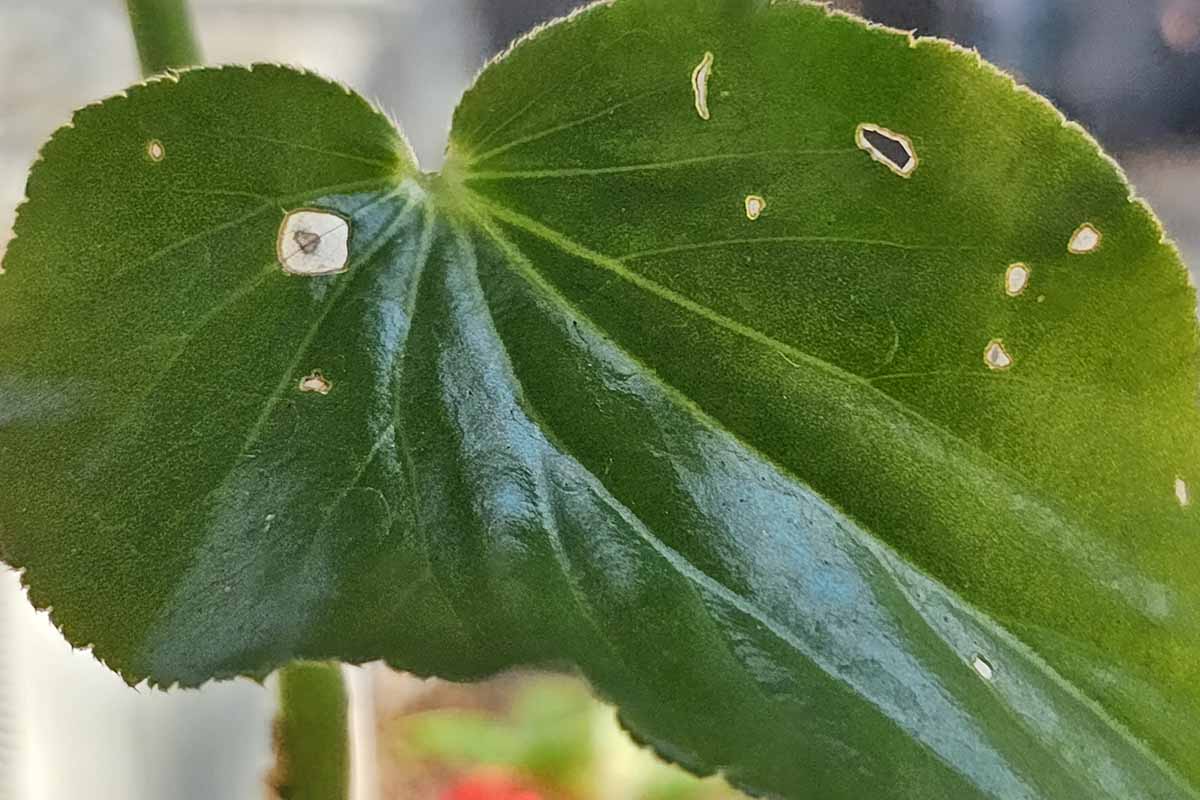

Limiting moisture or standing water under the vegetation helps scale back the dangerous water molds that trigger root or stem rot.
Overly damp soil or moist leaves can even lead to fungal illnesses like powdery mildew and leaf spot.
Be cautious of Botrytis cinerea, which causes a illness referred to as botrytis. Its harm seems on the flowers first and may be prevented by persistently deadheading blooms and eradicating fallen leaf particles.
Finest Makes use of for Angel-Wing Begonias
If you’re an indoor or outside gardener who prefers vegetation that bloom year-round and have evergreen leaves, angel-wing begonias are excellent.
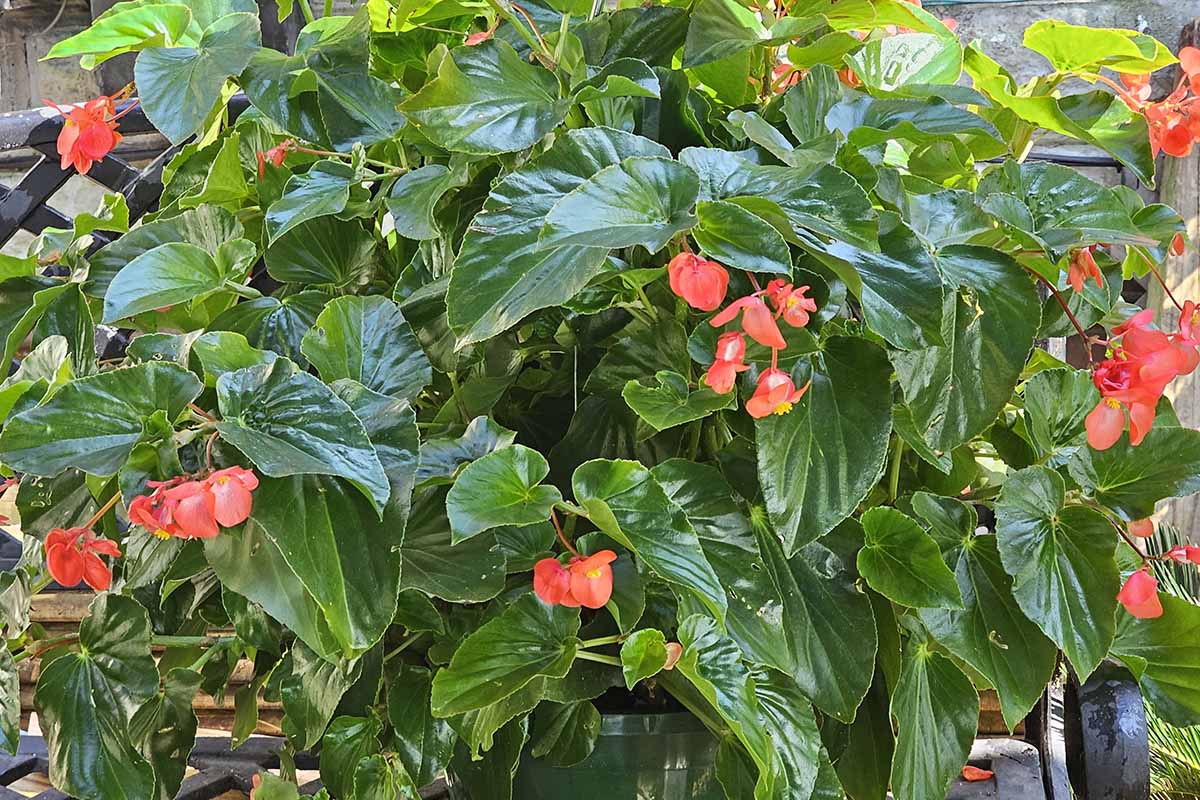

The taller specimens can anchor a spot on a shady patio backyard.
Or, you possibly can hold a extra modest selection clipped and formed to function a residing centerpiece on a well-lit eating room or kitchen desk. Simply be sure these calcium oxalate-rich leaves don’t fall within the salad!
Window containers, hanging baskets, an enormous pot within the well-lit lobby, or a well-draining backyard border lined with wing-shaped foliage and clusters of blooms are solely the beginning. When you begin rising angel-wings and propagating cuttings, you’ll discover many makes use of for them.
Like my sister-in-law, I think about these ornamentals present for an enterprising preteen with a passion for flowers and a inexperienced thumb. Or, give one to your self!
Fast Reference Rising Information
| Plant Kind: | Flowering herbaceous perennial | Flower/Foliage Coloration: | Coral, pink, pink, or white/Vivid inexperienced, burgundy, green-gray, or silver with mild dots in buff, silver, pink, white |
| Native to: | Brazil | Water Wants: | Average |
| Hardiness (USDA Zones): | 10-11 | Upkeep: | Low |
| Bloom Time/Season: | 12 months-round | Tolerance: | Grownup rabbits, deer, some drought, warmth |
| Publicity: | Vivid, oblique mild (indoors), full to half shade (open air), no direct solar | Soil Kind: | Porous, peat-based rising combine formulated for indoor vegetation; well-draining humusy soil (bedding vegetation) |
| Spacing: | Pot 2-3 inches wider than root ball, bedding vegetation 2-3 toes aside | Soil pH: | 6.0-7.0 |
| Planting Depth: | Soil floor (seeds), even with soil floor (transplants) | Soil Drainage: | Nicely-draining |
| Top: | 2-5 toes | Household: | Begoniaceae |
| Unfold: | 2-3 toes | Genus: | Begonia |
| Widespread Pests and Illnesses: | Mealybugs, scale, slugs and snails, spider mites, thrips; Botrytis, leaf spot, powdery mildew, root and stem rot | Species: | Coccinea, corillina, dietrichiana, B. x hybrida |
A Host of Angelic Begonias
In the event you’ve ever conversed with me about hobbies for greater than quarter-hour, you’ve already discovered I’m enamored with begonias.


Colourful rex begonia varieties with clever, patterned leaves are at all times a best choice.
However angel-wing varieties have additionally earned my adoration with their shapely leaves and vibrant blooms.
A part of the draw is the household tie I informed you about. However the ease of propagating from canes is what really units these varieties above different begonias, for me not less than.
A couple of weeks in a cup of water, and presto! You could have extra cheery vegetation to share with your pals.
How about you? In the event you’ve grown these earlier than, indoors or out, we’d like to obtain your anecdotal recommendation or questions within the feedback part under.
And for extra details about rising begonias, try these guides subsequent:
[ad_2]


